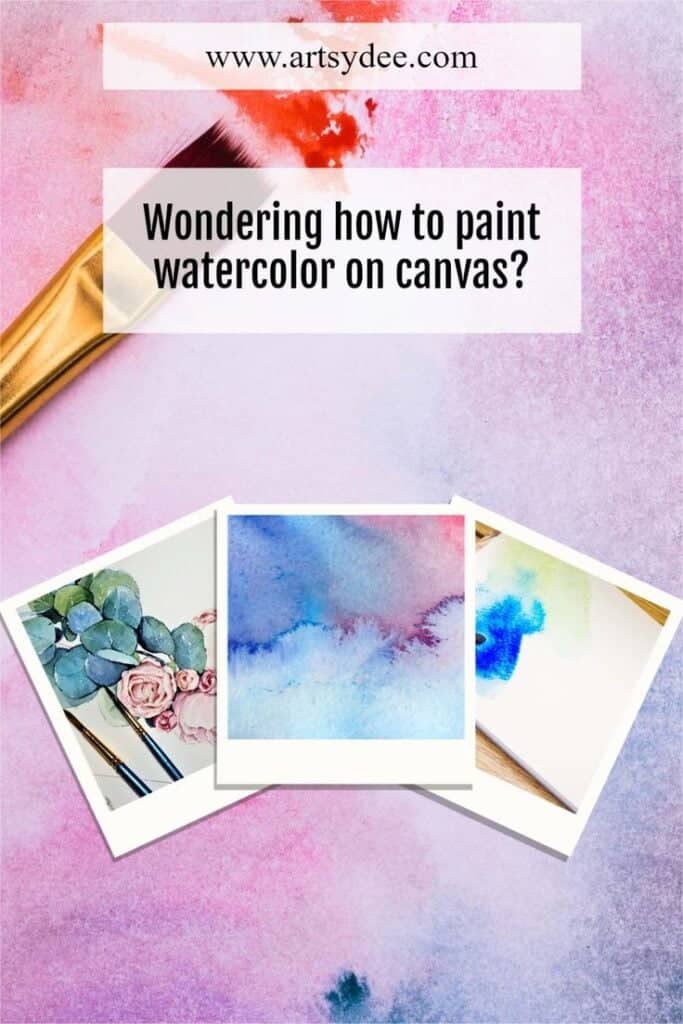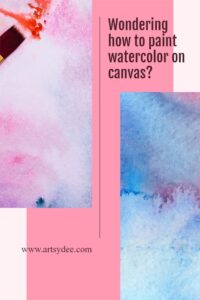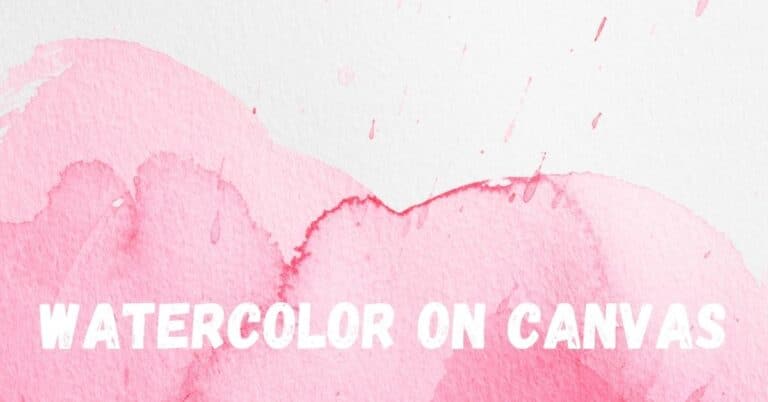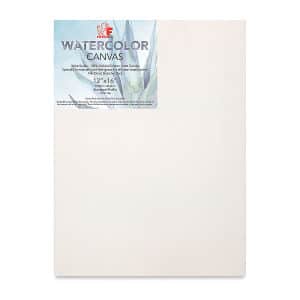Last Updated on December 21, 2023 by Dee
At some point in your art journey, you may have asked yourself this question – can you use watercolor on canvas? The answer is yes, but there are a few things you should know before starting.
In this blog post, I’ll discuss the pros and cons of using watercolor on canvas and provide some tips for how to make the most of this paint setup. So, whether you’re a beginner or an experienced artist, read on to learn more about painting with watercolors on canvas 🙂

Does watercolor work on canvas?
**This page may contain affiliate links to products I have used or recommend. If you purchase something from this page, I may receive a small percentage of the sale at no extra cost to you.**
Unfortunately, watercolor does not work well on the standard stretched canvas you buy at the store. The canvas doesn’t hold the watercolor well and the paint tends to run off the surface.
As a result, you don’t get the same beautiful watercolor effect as you would on watercolor paper.
Watercolor includes a variety of techniques such as wet on wet technique, wet on dry, and more. It’s a fun medium to experiment with! However, as the name states, it is all about water!
As a result, you need a paper that will be able to absorb the water without being ruined. Moreover, you also need to have paint that will work on top of the paper with its wet surface.
In my opinion, the easiest way to achieve a beautiful painterly watercolor effect is when painting on watercolor paper, or a watercolor board. You can then mount your final artwork and frame it.
However, perhaps you love that box-mounted effect of a painting on canvas and you feel like that might just give your art the edge it needs? Fortunately, there are solutions to this! Read on…
Watercolor paper vs traditional canvas
Watercolor paper is specifically designed for watercolor painting and it has a slight tooth or texture that helps the paint grab onto the surface. This also prevents the paint from running off the paper.
Canvas does not have this same tooth and, as a result, it can be more challenging to work with watercolors on canvas.
However, if you would like to paint watercolor directly onto a stretched canvas then there are ways to make this work. You just have to be a bit more creative with your approach.

The Best Watercolor Paper for Watercoloring
There are two main categories of watercolor paper that you can use for painting on.
The first is cold-pressed watercolor paper. This is the most basic type of watercolor paper and it has a textured surface. We say that this textured surface is called tooth.
It is great to work on cold-pressed watercolor paper because the ridges and mounds of the texture of the paper really help to hold the pigment of your watercolor paint and leave a beautiful, authentic watercolor effect.
The second type of watercolor paper you can use is hot-pressed paper. This type of paper has a very smooth surface, which is ideal for blending colors together to create beautiful watercolor effects.
When you first start watercolor painting it is a good idea to get samples sheets of both cold-pressed and hot-pressed watercolor paper.
I always recommend experimenting and playing with any new medium or material so that you get a feel for it.
Many watercolorists are adamant that it’s always best to paint on cold-pressed paper. However, many successful watercolor artists have been able to create beautiful watercolors on both types of paper.
[Related Article: Best Tape for Watercolor Painting]
In the end, it is just a matter of personal preference and experimenting to see what you like best! 🙂
I personally use Canson XL Watercolor Pads because I find the quality perfect and the pads are cost-effective!
Fabriano Artistico Traditional White Watercolor Paper is high-quality watercolor paper that is used by professional watercolorists throughout the world.
I use the Fabriano as well as Hahnemühle The Collection Watercolor Pad when I am painting watercolor commissions or making paintings that I intend to sell.
Watercolor over Gesso
Some people experiment with priming their canvas panels with gesso before painting on the surface.
Gesso is a thick white acrylic paint that works great for priming boards.
However, it can be challenging to use watercolor on gesso because the surface of the gesso is not smooth.
The pigment tends to just sit on top of the gesso and does not blend together very well with other colors
Gesso doesn’t offer adequate absorption of watercolor, and as a result, the paint is not absorbed enough. The gesso will not only affect the appearance of your paint, but it may also cause problems with your final surface!

Watercolor grounds on canvas
A better option for painting on canvas is to prime your canvas with watercolor grounds. This is a type of paint that is specifically designed for watercolor painting.
It has the tooth or texture of watercolor paper, which helps the paint hold onto the surface.
This will give you a much better surface to work with and you’ll be able to achieve the same beautiful painterly effects as on traditional watercolor paper.
I like to use Daniel Smith Watercolor Grounds because I find it has a lovely brushable quality and one to two coats usually is enough to provide an absorptive surface for watercolor.
Daniel Smith Grounds help you to create a more watercolor-like surface on your canvas.
I use a soft brush to create a more smooth finish, but you can also use a firmer bristle brush for more of a textured surface.
Once the Grounds have dried, you can then go ahead and paint directly on top of them with watercolors.
Steps for using watercolor ground on canvas:
1) Begin by painting two layers of gesso on your canvas first. This is important because it will give the watercolor ground something to adhere to.
2) Once the gesso is dry, mix up some watercolor ground and apply it to the canvas using a wide brush. Be sure to spread it around evenly.
3) Paint 2 to 3 layers of watercolor ground on your canvas allowing it to completely dry in between layers. It is a good idea to allow the watercolor ground to dry for a day so that it is completely dry before painting any watercolor over the top.
4) Once the watercolor ground is dry, begin working with your watercolors directly on the surface. You can paint one layer or several depending on how much texture and depth you wish to achieve.
5) If you want to add details after you have finished the painting, you can do so by using a fine liner or brush.
Here is a helpful video on watercoloring on canvas.

What is watercolor canvas?
Another option you have is to use a watercolor canvas. A watercolor canvas is a heavy, textured canvas that has been specially treated to absorb watercolor paint.
When you paint on this type of surface, the watercolors seep into the fibers of the material and create a classic watercolor effect.
This type of painting is very similar to painting with watercolors on paper because the paint is absorbed into the surface. It’s also not as fragile as paper because it is made of a thicker material.
Characteristics of watercolor canvas
- Heavier weight and texture than regular canvas
- Specially treated to absorb watercolor paint
- Paint is absorbed into the fibers of the material, creating a classic watercolor effect
- Very similar to painting with watercolors on paper
- Not as fragile as paper because it is made of a thicker material
Many watercolorists prefer to use watercolor canvas because it provides the same painting experience as traditional watercolor paper. The heaviness of the material and the texture of the surface help to create a more lifelike painting.

Watercolor-ready canvases I recommend
I like to use Fredrix Archival Watercolor Canvas Boards and Fredrix Archival Stretched Watercolor Cotton Canvas’s are top quality and help me achieve the depth of watercolor I am looking for.
It’s exciting to work with, and it provides a one-of-a-kind appearance that can only be achieved on canvas. With excellent lifting capacity for simple washes and corrections, it’s ideal for adding depth to your watercolor paintings.
It’s also lightweight, flexible, and long-lasting. It won’t bow or tear like paper because it’s sturdy and light.
I often scratch or scrape the surface of these watercolor canvases to attain unique effects.
I have not had problems with either surface bleeding so far, but do remember to allow the paint to completely dry before touching them again!
You can also use Fredrix Archival Watercolor Canvas Pads which I find to be a great option too.
They are very cost-effective and offer good quality, especially if you want to try or experiment with working primarily in watercolors, or if you have only just started watercolor painting on canvas.
Sealing your watercolor painting using
It is not essential to seal your watercolor painting on any surface, but it is a good idea to protect your work especially if you plan on transporting it to another location.
I use Krylon Gallery Series UV Archival Varnish which offers a protective surface that dries quickly to an invisible finish.
Wait two hours before handling artwork after applying varnish to avoid fingerprints, even though the varnish dries to touch in 10–15 minutes under normal circumstances.
You can also use Weber Matvar 53 Varnish. This is a type of Acrylic resin varnish which is a general term that refers to the non-yellowing, flexible, transparent material that does not crack or peel.
You want to make sure you have a soft mop brush to gently cover the surface of your watercolor canvas with this varnish.
Quick Steps to Seal your watercolor on canvas:
1) Allow your watercolor canvas to dry completely. Leave it overnight to make sure it is thoroughly dry.
2) Hold the Krylon Gallery Series UV Archival Varnish 30 cm away from the canvas and spray a thin layer over the surface.
3) Allow the varnish to dry completely for at least two hours, or until it is touch-dry. This will ensure your work will not get damaged when you touch it.
OR if using Weber Matvar 53 Varnish.
1) Allow your watercolor canvas to dry completely. Leave it overnight to make sure it is thoroughly dry.
2) Decant a small amount of the varnish into a small container.
3) Use your mop brush to apply a thin, even coat over the surface of your watercolor canvas.
4) Allow the varnish to dry completely for at least two hours, or until it is touch-dry. This will ensure your work will not get damaged when you touch it.
These are great options if you’re looking for a quick and easy way to protect your final watercolor canvas.

Word Of Note When using Watercolors On Canvas
It is very important that you allow the watercolor ground to dry completely before painting over it with watercolors. If you do not, the paint will run and create a mess.
It is also a good idea to protect the table or work surface you are using so that it does not get any paint bleeds on it.
Remember that painting with watercolor is all about achieving a balance between allowing the pigment to flow freely on the surface, and also controlling where it goes at the same time!
How about doing your next watercolor on canvas?
It is a great idea to try out different mediums, tools, and materials in your art-making journey. Don’t feel limited by only using paper. Do what feels right to you and enjoy the process!

Frequently Asked Questions about Watercolor on Canvas
Can you use watercolor on canvas without gesso?
Yes, but it is not recommended. To properly prepare the surface for watercolor the use of gesso or primer is advised.
Can you paint on canvas without priming?
No, this isn’t advisable since the ground will bleed and ruin your painting. It is best to prime your canvas before using it for watercolors.
How do you attach watercolor to canvas?
There are many ways you can attach watercolors to canvas, but one of the methods is applying an adhesive. Simply brush your adhesive on the area where you’d like to place your watercolor and lay it down on the surface.
How do you prepare a canvas for watercolor?
There are a couple of ways to prepare the canvas for watercolor. One is to use an acrylic primer and allow it to dry completely before painting over it with watercolors. Another option is to apply the gesso directly on your surface and give it enough time to dry before you paint over it with watercolors.
What kind of canvas do you use for watercolor?
There are many different types of canvases you can use when working with watercolors. One option is to use a cotton canvas that has already been pre-primed in gesso or acrylic primer. You can also purchase precut, watercolor canvases that are ready for paint.
What surfaces can you use watercolor on?
You can use watercolors on many different surfaces including canvas, paper, and wood.
Is watercolor or acrylic better for canvas?
Both watercolor and acrylic are great materials to use on canvas surfaces. It is up to you as the artist to choose which material works best for your art-making needs.
Is watercolor stronger than acrylic?
When compared with acrylic paint, watercolor is thinner and more fragile. It’s made up of pigment that has been mixed with water but doesn’t contain any binder to help it stick together.
What is the best way to clean up when working with watercolors?
The best way to clean up when working with watercolors is by rinsing your brushes with cold water. Simply hold them under running cold water until all of the paint runs out.

Which sheets are best for watercolor?
Watercolor paper is best for watercolors. It has a smooth surface with a high cotton content and is strong enough to handle repeated washes.
What paper do you use for watercolor pencils?
The most common type of paper used when working with watercolor pencils is watercolor paper. However, you can also try out specialty watercolor paper pads that are made for this medium.
Can you use watercolor paint like acrylic?
No, it is not recommended since watercolor paint is much more diluted than acrylic paint. If you use the two together in the same painting they will likely bleed and create a mess.
What do you put on canvas before watercolor?
Before applying your watercolors you can prime the surface with an acrylic primer or gesso. Then add 2 to 3 layers of watercolor ground. This will provide extra protection for your canvas and prevent bleeding.
How do you prepare a canvas for watercolor without gesso?
To prepare a canvas for watercolor without using gesso you can prime the surface with an acrylic primer. Then apply 2 to 3 coats of watercolor ground and allow it to dry before painting over it with your watercolors.

Conclusion
I hope this article has helped you understand the intricacies of watercolor on canvas, and given you some ideas for how to get started.
To learn even more about art in general, check out my other articles:)

Other articles you may enjoy…
What is the Right Digital Art Canvas Size?
21 Gorgeous Gifts for Watercolor Artists
7 Mesmerizing Watercolor Galaxy Ideas & How to Paint Them
13 Awesome Watercolor Backgrounds & How to Paint Them
Beautiful Stencils for Watercolor Painting



